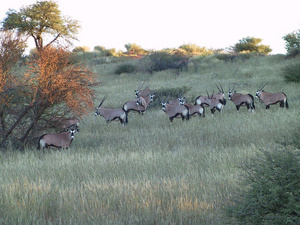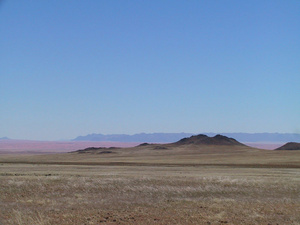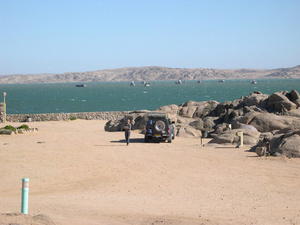Henk Dop: Namibia Trip Report 2005
Intu Africa, Garras Quivertree Camp, Lüderitz
Tuesday 19 April: Intu Africa; 0 km
Our two nights at Intu Africa were meant to start our trip with a moment of rest, and it looks like that's just what we need. A plan for some dawn birding fails in favour of extra sleep and a relaxed breakfast. I stroll around the dunes a bit, look at the various tracks, and play around with the tree book. Marike does some birding, Maarten has a longer rest.
Towards 1600 we get ready for the game-drive, have a cup of tea at the lodge, and are joined for the drive by a couple of Italian newlyweds. Bernd and Henrik pilot the vehicle, give us the usual warning about a bumpy ride ahead, especially when the Landrover storms up the crest of a dune. The drive offers the fine sights of the rolling parallel Kalahari dunes that we also wanted Maarten to experience, and there's a steady view of Ostrich, Springbok, Wildebeest, Oryx and the odd Steenbok. The reserve's small group of Giraffe has been breeding successfully, the sight of a tiny young is wonderful. We are not taken to the enclosure that holds the reserveís few Lions, subject of some bad publicity a few years ago when the press accused the reserve of feeding them with live donkeys. I ask Bernd about this when we stop for our sundowner, he asserts that these accusations have all been malicious fabrications.
When we continue, I'm disappointed that the Landrover heads straight back to the lodge, without doing a short night drive with the chance of seeing Bat-eared Fox in the spotlights that I'd been hoping for. A pity, we had some great sights of them last time. We prepare pasta with 'Oom Ras se wors', a tasty concoction. Marike turns in early, Maarten and I hang on a bit, and are rewarded by the sight of a couple of Giraffe passing by in the near-full moon, their slow browsing clearly audible. I try to take a late shower - but there's no water pressure.
Thursday 21 April: Garras Quivertree Camp - Lüderitz; 350 km
An early, chilly start and a hearty breakfast shared with Henrik, ready to roll at 0730. Not bad. On the B1 an idiot soars by at probably more than 160, coming up from behind like a bat out of hell. We pass Keetmanshoop and turn onto the B4, tarmac all the way down to Lüderitz. The road winds along the Klein Karrasberge and the Rooirand, which does its name justice, and then opens up onto a plain covered with yellow flowers and dense stands of Melkbos (Euphorbia damariana). After a brief photo stop at the Fish River, which still carries water, we stop for coffee by the roadside to find some Namibian-style graffiti: 'Jou Ma se kond' ('Your mother's ass' - but misspelled). The expression is to become one of the running gags of this trip.
Coming up to Aus, we now descend into a broad valley marking the edge of the central plateau, the golden hue of its dry grass almost painful to the eye. Then, just before Aus, the wide vistas of the Namibrand open up, offering views for tens of kilometres over the plains that slowly turn into the typical orange of the Namib desert. Aus, as expected, is little more than a roadside stop.
From here on, things steadily become drier and drier. A pair of Swiss cyclists, easily recognised as such by the flags on their bikes, laboriously work their way up to Aus in the fierce midday sun. Signs warn of crossing feral horses, an amazing population that somehow managed to thrive around here after having escaped from their Schutztruppe masters. We don't get to see any, just a lone Oryx in the distance. Work is being carried out on the railway to Lüderitz, it's obviously being completely renewed, and the works throw up huge clouds of dust.
Towards Lüderitz, signs warn of shifting sands, and a brisk wind indeed blows a steady flow over the road, with work crews constantly combating the moving desert. Alongside the road, dunes cover whole stretches of the former railway line, as well as a derelict station house. On our left, we pass the ghost city town of Kolmanskop, a century ago the epicentre of the free-for-all diamond boom until De Beers took over and the Sperrgebiet (restricted area) was created.
We enter Lüderitz around 1300, fill up, and drive around town. That takes little more than minutes in any direction: Lüderitz is just a small town, its architecture a German colonial anachronism, its only claim to fame being that it was where the first German (and highly dubious) colonial acquisition of land took place in 1883 by Mr. Lüderitz (first known as Angra Pequena, it was re-named into Lüderitzbucht, a settlement so remote and dry that, at first, drinking water had to be shipped in from the Cape! - see also www.namibweb.com/luderitz.htm). New initiatives, like an expansion of the port and fisheries industries, have sought to breathe new life into the local economy. Unfortunately, Namibian fisheries are now falling upon hard times as rising fuel costs, decreasing demands for its mainstay species of Hake and a strong Rand erode into their competitiveness.
Today's destination is Shark island, a former island now linked to the mainland by a broad causeway. It was to Shark Island that captive Nama fighters and their relatives were interned during and after the 1904-1907 Nama uprising, causing them to die in their hundreds from the harsh conditions on these cold and windswept rocks, until Oberstleutnant von Estorff's courageous personal intervention to move them onto the mainland. A small memorial marks their suffering. We check in at the campsite, try (and largely fail) to find a slightly sheltered spot, and have a challenging time setting up our tents. 'It's a bit windy now, but the wind will settle around 7 tonight', said the gatekeeper. The man must have been suffering from terminal optimism.
We stroll around town and the newly developed shorefront shopping mall, and quickly come to the conclusion that our plans for the next morning to go on a boat ride on the schooner 'Sedina' to see Sealions and Jackass Penguin on Halifax Island are best dropped: with this wind, I'd be sure to get violently seasick. As we continue through the town, I see that the shoe-store sells Namibian hand-made Sealion leather shoes, and buy a pair of nice veldskoene (field shoes). Back at the campsite, we get some great views of African Black Oystercatchers, and end up cooking our dinner as well as eating it in the shelter of the field kitchen, as the wind remains both fierce and cold.



